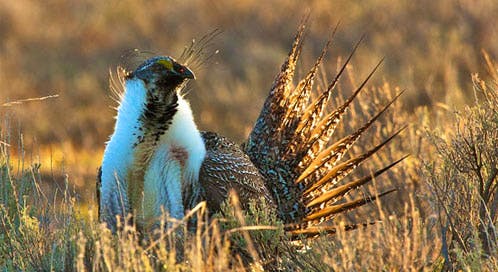Wyoming’s plan doesn’t fly for the birds
If you’ve happened to read almost any newspaper in the West over the past couple of months, it’s likely you’ve been introduced (or perhaps, reintroduced) to one of the most storied birds in our country’s history – the greater sage-grouse. The sage-grouse, a charismatic and quirky bird known for its elaborate mating dance, is as iconic to western landscapes as streaking antelope, bounding jackrabbits, beautiful native trout, broad vistas and rugged mountains.

“In time there were two as perfectly adjusted to their habitat as the sage. One was a mammal, the fleet and graceful pronghorn antelope. The other was a bird, the sage grouse – the ‘cock of the plains’ of Lewis and Clark.” – Rachel Carson (1962) Silent Spring. (©Tatiana Gettleman/Flickr)
Alas, sage-grouse are not doing so well. These ambassadors of the Sagebrush Sea (the expansive, sagebrush grasslands that epitomize the “West”) are in perilous decline. Once numbering nearly 16 million, there are now only about 200,000-300,000 scattered across their western range. The primary cause for the grouse’s decline is the loss and fragmentation of sagebrush habitat, which not only spells trouble for this bird, but also for more than 350 other flora and fauna of conservation concern that depend on sagebrush for survival.
In fact, development, oil and gas drilling, grazing and other threats have so reduced sage-grouse populations that the U.S. Fish and Wildlife Service determined they warrant protection under the Endangered Species Act. This has prompted a multitude of federal agencies and states to develop new conservation strategies for sage-grouse in an attempt to stave off listing.
The state of Wyoming, where about 37 percent of remaining sage-grouse live, has led the way on sage-grouse conservation. It completed the first statewide conservation strategy based on the concept of conserving areas of core habitat for sage-grouse. Core areas are those critical places, like breeding sites, that are essential to sage-grouse survival and which, if properly preserved, would help ensure the species conservation and recovery. The state of Wyoming considers its plan a model that federal agencies and other states should use to alleviate the need to federally protect the species.
Unfortunately, and although the Wyoming plan has its merits, key components of the strategy are not in accord with the best available science on sage-grouse and are unlikely to protect sage-grouse from ongoing threats, particularly oil and gas drilling. “In fact, federal agencies and other states should avoid adopting the Wyoming strategy if their goal is to conserve sage-grouse,” says Defenders’ sage-grouse expert, Mark Salvo.
Defenders of Wildlife released a report on Friday, “The Core Problem,” that compares the Wyoming plan against the best available science on sage-grouse conservation (much of the research and analysis was developed in Wyoming), and concludes that the strategy simply is unlikely to save sage-grouse.
Some of the problems with the Wyoming strategy involve safe zones, or “buffers,” around leks, protection for winter habitat (the places where the birds survive during the long, cold, snowy winter) and the level of habitat disturbance allowed in core areas—that is, development, drilling and other activities that degrade habitat and disturb sage-grouse.
“Wyoming’s protective buffer around sage-grouse breeding sites is six times smaller than that recommended by the current best available science,” says Salvo. “Additionally, the cap on disturbance in sage-grouse habitat is almost twice as high as recommended by scientists. The strategy must do more to protect critical breeding habitat and wintering areas from energy development and other threats, and limit disturbance in priority habitat to secure a future for sage-grouse in Wyoming.”
There is still time to improve plans like Wyoming’s Core Area Strategy, along with the many other draft sage-grouse conservation plans that are in the works. By taking the right steps to conserve the birds now, we can ensure their place in the great American West. Defenders will continue to apply science to policy to advocate for the strongest protections possible for imperiled species like sage-grouse and the landscapes where they live. Developing and using comprehensive, analytical, science-based reports like “The Core Problem,” Defenders can and will continue to illuminate the plight of sage-grouse and advocate for adequate protections for these birds and their iconic western habitat, the Sagebrush Sea.
Courtney Sexton is a Communications Associate for Defenders of Wildlife




